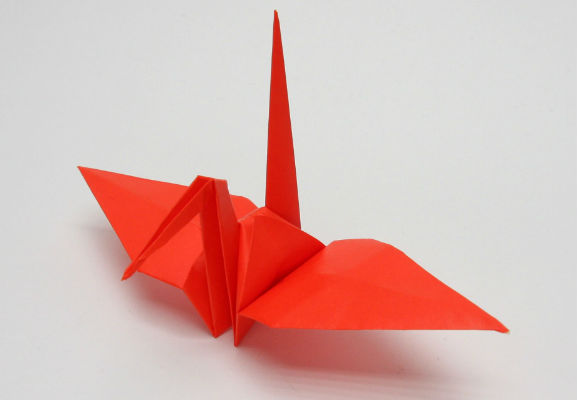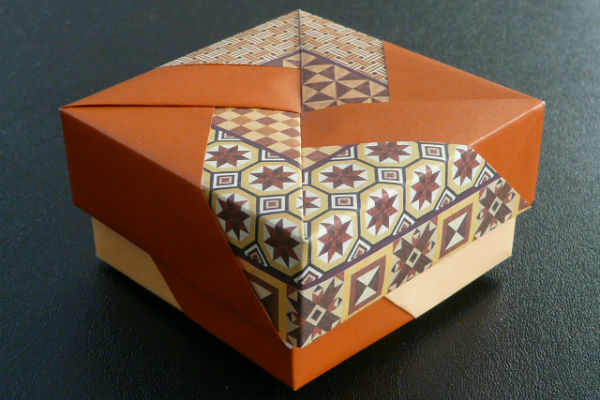History of Origami All About Japan
![]()
Origami
There can hardly be a western person who didn't, as a child, make a paper airplane using folded newspaper or a sheet from a notebook. The more adventurous might have made a hat or, if they were lucky, might have been introduced to the almost limitless possibilities that origami and a creative mind can conjour up. These days, while some people consider it a real art form that is very Zen-like in its simplicity and depth, origami is regarded mainly as an activity for children, who are taught just a few standard designs. Even in Japan, the most complicated design that most people master is the tsuru (crane), which has developed into a worldwide symbol of children's desire for peace. But origami has a long history and was originally not for children at all.

An elaborate origami pattern

A simple origami tsuru
Like many things in Japanese culture, origami (from "oru" meaning to fold, and "kami" meaning paper) has its origins in China. It is believed that paper was first made, and folded, in China in the first or second century. The earliest records of origami in Japan date to the Heian Period (794-1185). It was during this period that Japan's nobility had its golden age and it was a time of great artistic and cultural advances. Paper was still a rare enough comodity that origami was a pastime for the elite. Paper was folded into set shapes for ceremonial occasions such as weddings. Serrated strips of white paper were used to mark sacred objects, a custom which can still be seen in every shrine to this day.
It was in the Edo Period (1600-1868) that much of today's popular traditional culture developed as forms of entertainment for the merchant classes and the common people. Kabuki and ukiyo-e are just two examples and origami also gained poularity. By the mid-19th century, 70 or more different designs had been created. But aside from its ceremonial use, its popularity has been in decline since the Meiji Period (1886-1912) and the modernization of Japan.
In the mid-1950s, 11-year old Sasaki Sadako developed leukemia as a result of her exposure to radiation as a baby during the atomic bombing of Hiroshima in 1945. Tradition held that if you made a senbazuru (a thousand paper cranes) and made a wish after completing each one, your wish would come true. Sadako set about making the tsuru, wishing for her own recovery. As she continued, she began to wish instead for world peace. One version of the story says that she died when she had made only 644 and her school friends completed the full number and dedicated them to her at her funeral. A perhaps more reliable version says she completed the 1,000 and went on the fold several hundred more before succumbing to the cancer at the age of 12. Regardless of the details, the story helped inspire the Children's Peace Memorial in Hiroshima and a statue of Sadako in Seattle. Each year on Peace Day (August 6th), tens of thousands of origami tsuru are sent to Hiroshima by chidren all over the world.

This origami box is surprisingly simple to make

Thousands of origami tsuru at an atomic bomb memorial in Hiroshima
There are too many folding steps in making a tsuru for me to describe simply here and lots of sites already provide this and many other ideas.
In more recent times, the Internet has helped spread the word about Japanese culture, both the long-hidden aspects and the things that western people had heard of but knew little about. Origami is one such facet that lends itself to the visual medium. Designs can be explained in line diagrams or photos and, with practice, can be mastered by anyone. The next step, as with any art form, is to find a topic or field that appeals and develop your own style. In the words of Yoshizawa Akira, the 'acknowledged grandmaster of origami, the father of modern creative origami':
"You can fold a simple quadrilateral paper into any shape as you want. I wished to fold the laws of nature, the dignity of life, and the expression of affection into my work...Folding life is difficult, because life is a shape or an appearance caught in a moment, and we need to feel the whole of natural life to fold one moment."
Related content:
- Sado - Tea Ceremony
- Ikebana - Flower Arranging
- Bonsai - Trees in Miniature
- Kodo - The Way of Incense
- Geisha
History of Origami All About Japan
Source: https://www.japan-zone.com/culture/origami.shtml
0 Response to "History of Origami All About Japan"
Post a Comment